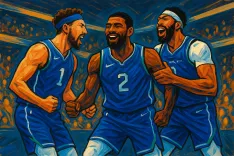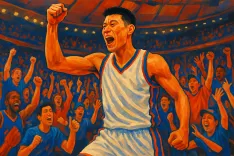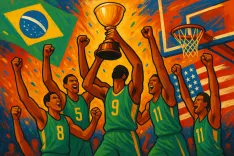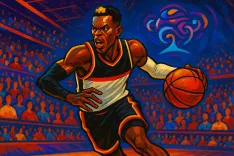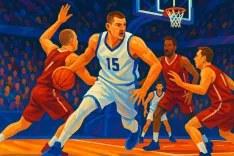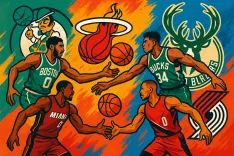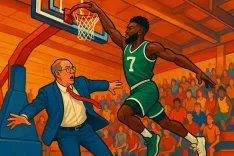2025 NBA Playoffs: Analyzing Winners and Losers Ahead of the Finals

As the 2025 NBA Finals approach, the playoffs have already delivered weeks of remarkable highlights, intense matchups, and significant performances that have influenced the narratives of the era. While there are still memorable moments to anticipate, the postseason has provided ample material to evaluate thus far. This analysis will explore the major stories from the playoffs through the lens of 'winners and losers.'
Throughout the 49 seasons since the NBA-ABA merger in 1976, franchises such as the Boston Celtics, Chicago Bulls, Golden State Warriors, Los Angeles Lakers, and Philadelphia 76ers have made a combined 43 Finals appearances, despite varying size of media markets. This season, however, the playoffs marked the absence of both the 76ers and Bulls, alongside early exits for the Lakers, Warriors, and a New York Knicks team that made it to the conference finals but was ultimately eliminated. Unlike the NFL, which has enjoyed a history of competitive parity, the NBA has been characterized by dynastic teams and established markets regularly competing for championships. The potential match-up in the upcoming Finals appears to abandon this tradition, with the Indiana Pacers and Oklahoma City Thunder coming from smaller markets.
Owen Phillips, a writer for The F5 newsletter, suggests that basketball's framework aligns closely with the concept of strong link sports, where the presence of the best player in a series typically determines the outcome. He contrasts this with weak link sports, where it is the performance of the less skilled players that can undermine a team. According to Phillips, in the playoffs, poor defenders are often targeted, while non-scoring players are disregarded. Consequently, the success of a team hinges on both its star players and the overall depth of the roster. The Pacers and Thunder, both teams still in the postseason, showcase a depth of nine to ten reliable contributors, minimizing weak links in their lineups. With the trend of relying heavily on star players being questioned, teams will need to prioritize finding young, cost-effective talent to be competitive moving forward.
LeBron James and Stephen Curry represent two of the league's most prominent figures from major markets; however, both have fallen short of contending this postseason. With this year's playoffs seeing other notable players like Kevin Durant, Chris Paul, Damian Lillard, James Harden, and Kawhi Leonard eliminated early, it may signal the closing chapter for the Curry and James era. Meanwhile, teams such as the Thunder, Pacers, Houston Rockets, and Minnesota Timberwolves are rising. This shift reflects a broader evolution in the NBA as future stars emerge, with the likes of Shai Gilgeous-Alexander, Jalen Williams, Chet Holmgren, and Anthony Edwards showcasing their talent.
Despite the potential for a temporary lull in star power following the careers of James and Curry, this season has provided insight into the next generation of superstars. Notable performances from Gilgeous-Alexander and his teammates highlight the emergence of new talent. Additionally, while discussions continue surrounding the traditional 82-game schedule, arguments favoring a reduction are gaining traction, particularly in light of injuries sustained by key players like Jayson Tatum and Damian Lillard during this postseason.
The ongoing discourse about season length reflects broader concerns regarding player health and the potential impact on competitive dynamics within the league. Fewer games may ensure healthier teams and more engaging playoffs; however, maintaining a balance to preserve the integrity of record-breaking statistics is equally vital. Additionally, the recent in-season tournament format, while still meeting some resistance, appears to be fostering competitive motivation for teams like the Pacers and Thunder, both of which have demonstrated resilience throughout the playoffs.
The Cleveland Cavaliers, despite an impressive regular season record, failed to make a lasting impression in the postseason. Questions regarding the chemistry between their backcourt duo of Darius Garland and Donovan Mitchell loom large, especially in light of their early exit to the Pacers in just five games. With their past performance indicating potential championship aspirations, the Cavaliers now face a summer filled with speculation about roster adjustments and player fit.
In contrast, the Pacers have emerged as a prime example of patience and strategic development. Avoiding rash decisions despite prior setbacks, they built off their success in past seasons, trusting trades and player growth to advance to the Finals. Their contributions on the court embody the benefits of run-and-gun basketball, emphasizing depth and teamwork. Notable performances from Tyrese Haliburton, combined with Pascal Siakam's impact, signify the value of maintaining stability within a roster as the foundation for success.
On the other hand, the Denver Nuggets experienced a tumultuous postseason filled with disappointment, culminating in the firing of their coach and general manager following their second-round exit. Nikola Jokić's prime continues to pass without a title, and while they displayed significant skill in pushing the Thunder to seven games, questions around their direction loom. Despite calls for dramatic roster changes, there may be merit in making minor adjustments to maximize potential.
The Thunder's playoff run has largely appeared predictable, bolstered by a record-breaking season in various metrics, accompanied by the presence of the league's MVP in Shai Gilgeous-Alexander. With a well-rounded roster and promising contributions from players like Jalen Williams, OKC stands as a favored team heading into the Finals. Their deep talent pool further solidifies their position as one of the postseason's most significant success stories.
